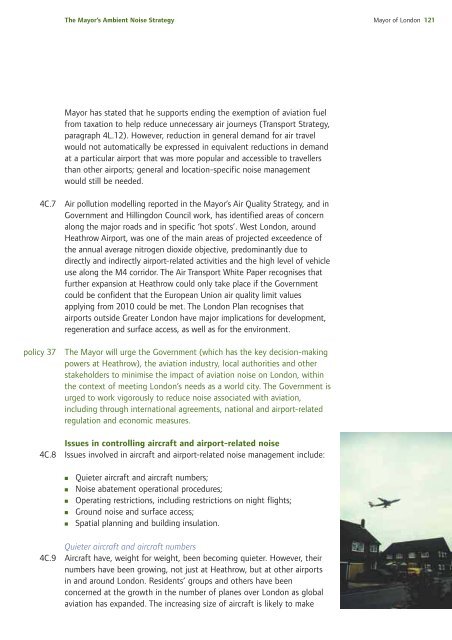The Mayor's Ambient Noise Strategy - Greater London Authority
The Mayor's Ambient Noise Strategy - Greater London Authority
The Mayor's Ambient Noise Strategy - Greater London Authority
Create successful ePaper yourself
Turn your PDF publications into a flip-book with our unique Google optimized e-Paper software.
<strong>The</strong> Mayor’s <strong>Ambient</strong> <strong>Noise</strong> <strong>Strategy</strong> Mayor of <strong>London</strong> 121<br />
Mayor has stated that he supports ending the exemption of aviation fuel<br />
from taxation to help reduce unnecessary air journeys (Transport <strong>Strategy</strong>,<br />
paragraph 4L.12). However, reduction in general demand for air travel<br />
would not automatically be expressed in equivalent reductions in demand<br />
at a particular airport that was more popular and accessible to travellers<br />
than other airports; general and location-specific noise management<br />
would still be needed.<br />
4C.7 Air pollution modelling reported in the Mayor’s Air Quality <strong>Strategy</strong>, and in<br />
Government and Hillingdon Council work, has identified areas of concern<br />
along the major roads and in specific ‘hot spots’. West <strong>London</strong>, around<br />
Heathrow Airport, was one of the main areas of projected exceedence of<br />
the annual average nitrogen dioxide objective, predominantly due to<br />
directly and indirectly airport-related activities and the high level of vehicle<br />
use along the M4 corridor. <strong>The</strong> Air Transport White Paper recognises that<br />
further expansion at Heathrow could only take place if the Government<br />
could be confident that the European Union air quality limit values<br />
applying from 2010 could be met. <strong>The</strong> <strong>London</strong> Plan recognises that<br />
airports outside <strong>Greater</strong> <strong>London</strong> have major implications for development,<br />
regeneration and surface access, as well as for the environment.<br />
policy 37<br />
<strong>The</strong> Mayor will urge the Government (which has the key decision-making<br />
powers at Heathrow), the aviation industry, local authorities and other<br />
stakeholders to minimise the impact of aviation noise on <strong>London</strong>, within<br />
the context of meeting <strong>London</strong>’s needs as a world city. <strong>The</strong> Government is<br />
urged to work vigorously to reduce noise associated with aviation,<br />
including through international agreements, national and airport-related<br />
regulation and economic measures.<br />
Issues in controlling aircraft and airport-related noise<br />
4C.8 Issues involved in aircraft and airport-related noise management include:<br />
■<br />
■<br />
■<br />
■<br />
■<br />
Quieter aircraft and aircraft numbers;<br />
<strong>Noise</strong> abatement operational procedures;<br />
Operating restrictions, including restrictions on night flights;<br />
Ground noise and surface access;<br />
Spatial planning and building insulation.<br />
Quieter aircraft and aircraft numbers<br />
4C.9 Aircraft have, weight for weight, been becoming quieter. However, their<br />
numbers have been growing, not just at Heathrow, but at other airports<br />
in and around <strong>London</strong>. Residents’ groups and others have been<br />
concerned at the growth in the number of planes over <strong>London</strong> as global<br />
aviation has expanded. <strong>The</strong> increasing size of aircraft is likely to make
















